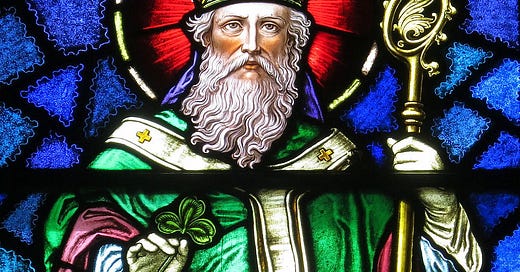If I could be anywhere today, I would spend the afternoon in JJ Cathedral, better known simply as The Irish Pub, which occupies a slim yellow-and-green fronted building at the corner of the Piazza di San Giovanni in Florence.
For one reason or another I have a soft spot for the niche category of ‘Irish pubs outside Ireland’, and this one is a doozy. From the first-floor balcony, you can look out towards the glorious Romanesque Baptistry of St John, and beyond it the ‘Duomo’ - aka the Cathedral of Santa Maria del Fiore.
So I should very much like to be there this St Patrick’s Day afternoon, sloshing strong beer out of three-litre pitchers and telling strangers I was named after Dan Murphy, an Irish great-grandfather I never met. All the while admiring some of the greatest medieval architecture in the world, just a cig-butt’s flick from the end of my nose.
St Patrick was a great traveller, of course. He was born in the first half of the fifth century (probably), in a place named as ‘Bannavemtaberniae’ somewhere around Hadrian’s Wall (probably), in what had been the the extreme north of the western Roman Empire before the legions withdrew from Britannia in 410AD. He was captured by slavers as a teen and taken to Ireland, but later found his way to Gaul, where he studied at various abbeys and was ordained as a bishop by St Germanus of Auxerre.
Patrick then went back to Britain and, from there, to Ireland, where he preached God’s word and performed miracles, thereby laying the foundation for a distinctive Celtic form of Catholicism and monasticism. Today, of course, he is Ireland’s patron saint, and his feast day - March 17th - follows the best traditions of medieval festivals, combining as it does Christian observance with an excuse for good-humoured drunkenness. All power to Paddy’s elbow.
There is a great deal we could say about the importance of St Patrick and the bishops of Ireland who followed him, with regard to the history of medieval Christianity - its visual and literary culture and its divergent strands of monastic tradition. I wrote a little about this in my most recent book, Powers & Thrones. But some days legends are more entertaining than history, and I think this is one of them.
So what I want to share with you now are a few extracts from St Patrick’s hagiography, as related in The Golden Legend, the compendium of saints’ lives assembled in the thirteenth century by Jacobus de Voragine. If you ever wanted to know who Saint Patrick was, why it was a bad idea to steal sheep in his presence, and what the deal was with the snakes, well, here you go.
Keep reading with a 7-day free trial
Subscribe to History, Etc to keep reading this post and get 7 days of free access to the full post archives.




